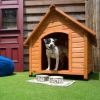
Moving interstate with your pets
It is always a good idea (and a necessity if they are going to be air transported) to book your pet in for a check-up prior to travelling to ensure they are in good health for the trip. For air travel your pet will require a current vaccination certificate to prove that their vaccines are up-to-date, it is also a good idea to get a certificate from your vet outlining your pets health as some airlines will require this also.
Next you will need to organise a travelling container. Even if they are travelling in your car, it is good practice to transport a pet in a container to prevent serious injury in the case of an accident and also to ensure the driver is not distracted by an animal roaming the car. Various companies sell pet containers and some also hire them if you only need it for a one-off trip.
It is important to include some of your pets familiar favourite items to have in their container for travel to ensure that they are relaxed and comfortable as possible. A few toys, blankets or other comforting items can make a world of difference to a nervous pet.
When travelling by air, by sure to add a tag to your pets travel container they has their name, your name and your contact details on it.
Always give your pet a good amount of exercise prior to travel and ensure that they eat only a minimal amount before travelling. Keep them well hydrated with water available at all times - this will necessitate the need to have an absorbant mat in the bottom of the cage as well. Be sure to carry a lead so you can exercise your pet when it is possible that they can leave the travelling container but are not in a familiar area.



